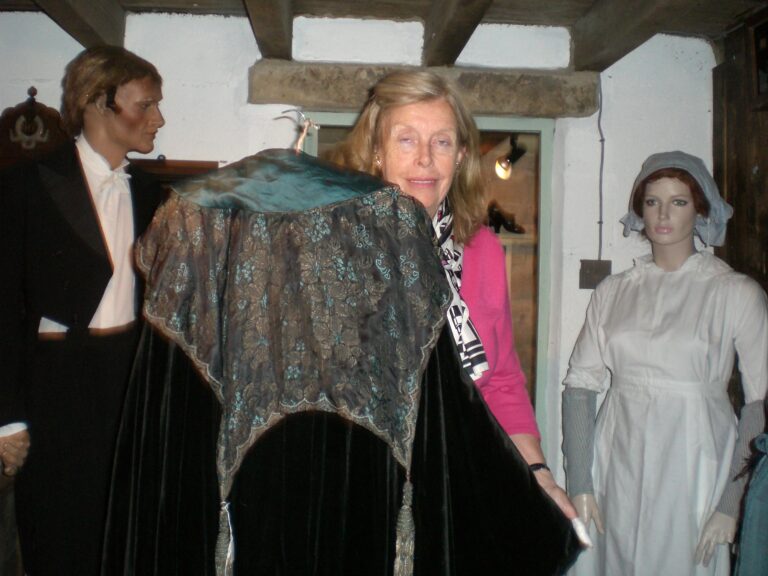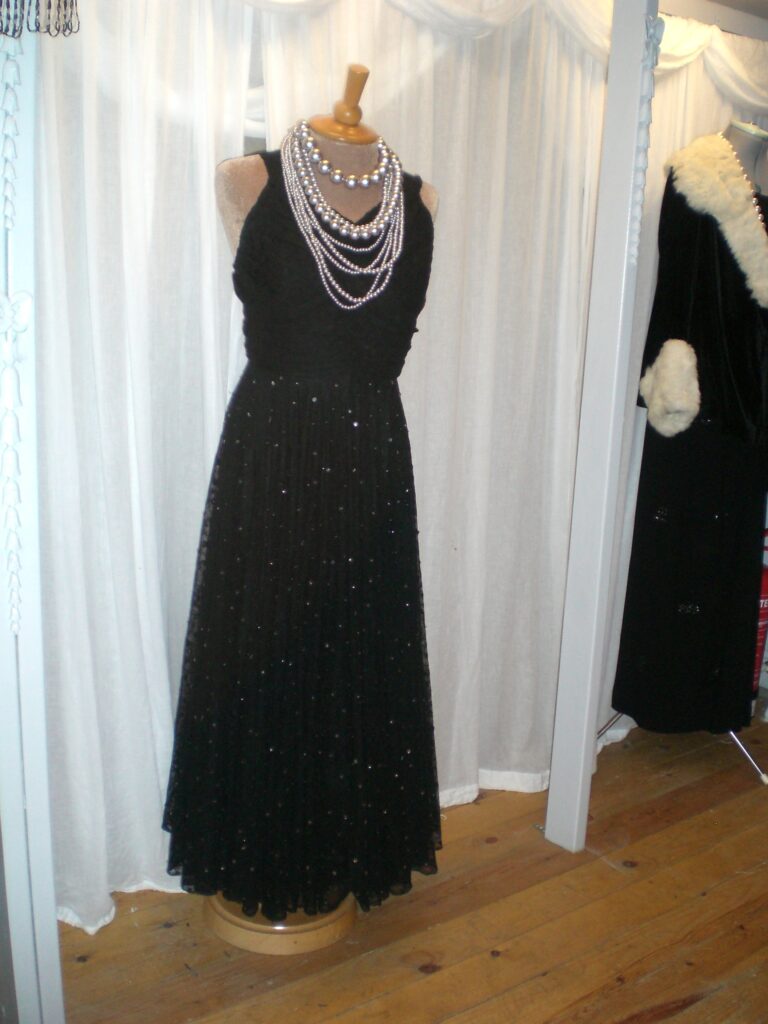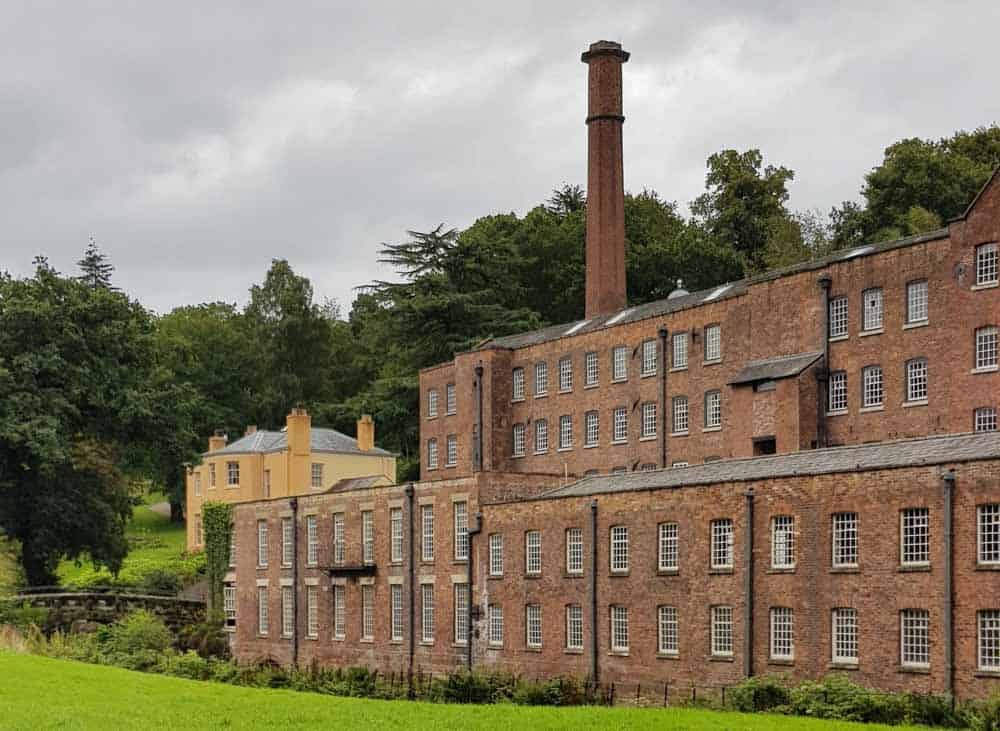
Notty Hornblower with a cape
It is so refreshing in these recessionary times, to meet someone who not only has a passion but moreover has developed it into a business; so it is with Notty Hornblower, Keeper of the Hope House Costume Museum in Alstonefield. Her life-long love of vintage costume and textiles has made her a renowned expert in the field, recently being appointed as consultant to Hansons Auctioneers dealing with their Vintage Textiles and Costumes.
Needless to say Notty is a nickname but I could not discover what her real given name was since she was distinctly cagey about divulging it. Being an inquisitive type, I found this most mysterious and was keen to know if it really was a less than desirable Christian name that she owned.
So not only is she an unusual lady, Notty is a real force of nature and has assembled an enormous collection of costumes dating back to the Georgian period but also runs a museum and restoration workshop; keeping very busy she gives talks, has fashion and textiles students doing research and presents vintage fashion shows through-out the surrounding counties, some of which raise funds for various charities.
I asked Notty how she got started with her love of costumes and textiles, and she told me, “It all started with me doing a Dress design evening class while I was at Technical College. Having always loved fashion, vintage and antiques, I regularly used to wear my grandmother’s clothes as a child. I find it fascinating to think of all the social history behind items – there were such vast differences between the middle classes and the working classes as you will see by their dress when I show you around the Museum”. I soon found that Notty can quote the provenance of every piece to which she is guardian.
In the Georgian and Regency periods , wives of the wealthy upper classes would not have worked so the elaborate styles they wore would have been appropriate for sitting around stitching tapestries, visiting their neighbours, riding out or taking the waters in fashionable spa towns. The styles of the fashions would have been much influenced by Europe since the English kings from1795 to 1837 married Princesses from states in what is now modern day Germany, and the rich and fashionable particularly at court would always have mimicked the monarchy.

In 1837 Victoria came to the throne and she and her daughters’ fashion was yet again influenced by European clothing, characterised by increase in the width of women’s skirts supported by crinolines or hoops. For men, the sack coat as informal daywear was introduced and outfits with matching coat, waistcoat and trousers marked the beginnings of the modern business suit.
Full-skirted fashions of the 1850s and 1860s, consisted of fullness in womens’ skirts moving to the rear with elaborate draping held in place by tapes and supported by a bustle, (this style re-emerging again in the mid-1880s). Underskirts were worn, heavily trimmed with pleats, ruching, and frills. This was short-lived to be succeeded by a tight-fitting silhouette with fullness as low as the knees: a form-fitting, long-waisted, boned bodice reaching below the hips, and the princess sheath dress. Evening dresses had low necklines and very short, off-the-shoulder sleeves, worn with short gloves, later mid-length. Other characteristic fashions included a velvet ribbon tied high around the neck and trailing behind for evening (the origin of the modern choker necklace). 1870s fashion gradually returned to a narrow silhouette, with the pendulum going full circle.

Innovations in men’s 1870s fashion included patterned or figured fabrics for shirts and replacing neckties tied in bow knots with the four-in-hand modern day method of tying ties, and later the Ascot tie.
The Upstairs Downstairs segregation of the classes is very clearly demonstrated with exquisite outfits made for the wealthier in the best of colourful fabrics such as fine silks, with elaborate hand embroidery, extravagant buttons, lace trims and sequins, together with fancy accessories such as beautiful hats, gloves and furs, and all in the latest fashions, invariably dictated by the French. The more affluent would have had distinct clothes for different parts of the day; luncheon dresses, day dresses, riding habits and evening wear for dinners, and the men would also have had informal and more formal wear as appropriate.
Delineated from the wealthy, the poorer classes would have more ‘make do and mend’ clothing with many of the servant classes clothed daily in the insignia denoting their positions; maids in black dresses with white, starched aprons and caps; valets and footmen in livery, the uniform provided by their employers, making them as anonymous was the choice of new names for them to fit in with the households.
Along with the different costumes from various eras, Georgian, Victorian, Edwardian etc, Hope House Museum displays many of the accoutrements such as bicycles and perambulators appropriate to the years of those relevant fashions, all set out in striking, picturesque tableaux.
The changes evident in the styles through the centuries are in correlation to the history of the particular time, (after 1913 showing a glimpse of ankle became so daring). Later after the austerity of the earlier war years, the Flapper epitomised the spirit of a reckless rebel dancing the nights away in the Jazz Age of the 1920s. A fashionable flapper would have had short sleek hair, worn shapeless shift dresses, be flat-chested, wearing make up even applying it in public and smoking cigarettes using a long holder; The French called the fashion style the ‘garçonne’ since it was very masculine. One famous person who adopted the long, flowing scarves so popular in that age was the dancer, Isadora Duncan, who met her end when it got tangled up in the open-spoked wheels of the car she was travelling in.
Notty said she had been collecting vintage costumes and textiles since 1976, establishing her own costume Museum in 1997 locally in Alstonefield. “The adjacent barn was originally owned by the house but had been sold off – I was lucky when the owner died, his nephew offered it back to me saying that he wouldn’t sell it to anyone else, since he knew about my collection”. The barn is now a perfect backdrop for the exquisite exhibits showcasing the changes over many decades of dress. Because of the unique nature of the costumes, the environment needs to be maintained at a constant temperature in the barn with humidifiers.
The many cats in evidence around the property ensure no rodent damage to the priceless exhibits; and whilst many premises advertise Guard Dogs patrolling, Notty’s sign in the window is far more quirky stating Killer Kitties on Nightly Mouse Patrol!!
In the 1990’s Notty spent 4 years gaining experience at Pickford House Museum in Derby; she is also a member of The Costume Society and the East Midlands Museum Service. She showed me yet another of her awards displayed on the stairs, saying, “These are all the awards I’ve had and this is the latest one from Derby Museum”.
The museum is laid out in eras – frequently being changed around to be topical and based on television dramas, such as when Downton Abbey became so popular, together with another programme, Strictly come dancing.
Her collection covers costume and accessories from 1770, the time of George III’s reign, up to the 1970’s and now amounts to well over 10,000 items.
She regularly takes students from local Universities and Colleges for work experience. She was clearly proud when she told me, “One of my students worked on the Royal wedding dress recent recently, but it had to be in secret at the time”. Taking work experience students from school means that her public liability insurance is considerable, with conservation work on the garments being carried out by volunteers and students.
Her riveting talks include: Vapours to votes, Mr Selfridge, Downton, Putting on the Ritz (20s & 30s), Make do & mend & The New Look, Dreamboats & petticoats & the Mini, Strictly Ballroom, and Here comes the bride, for which she has a choice of around 180 wedding dresses.
“One recent fashion show I produced was entitled 200 Years of Fashion; we held it in Edensor Church at Chatsworth. The lack of space there made it a logistical nightmare but we were successful in raising funds for charity”.
Her collection currently spans approximately1800 frocks, 10,000 accessories such as fans, shoes and handbags, 500 men’s outfits and 500 children’s outfits, with Notty frequently having further items donated.
When asked which item was her favourite piece, Notty delved into her store of costumes and with a flourish said, “This,” bringing out a stunning cape completely covered in sequins. Another delightful accessory was a clutch bag decorated on the front with ivory elephants dating back to the Art Deco period.
Preservation of the items Notty takes in is very delicately undertaken with clothes firstly hung on padded hangers, steamed and then packed in boxes in acid free tissue for storage.
Viewing of the museum exhibits is solely by appointment on 01335 310318 with the option of groups receiving home made refreshments. The season, weather permitting, runs from March through to November.
When asked what items she would still like to add to her collection, Notty said, “Suffragette memorabilia seems to be in very short supply. If anyone has any items they might wish to help me out with by donating, I would be very interested”. She is intending to do a suffragette display next year, 2014, so anyone who can help should contact her at info@hopehousemuseum.co.uk.
Deborah Barham Smith
October 2014
Hope House Costume Museum http://www.hopehousemuseum.co.uk
Reproduced by kind permission of Reflections Magazine.


